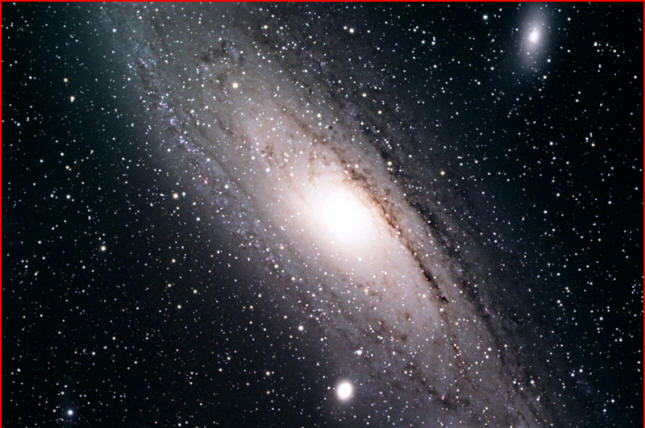
home •
about •
essential guide •
picture of the day •
thunderblogs •
news •
multimedia •
predictions •
products •
get involved •
contact
picture of the day archive subject index
Credit and copyright: John Smith, Hidden Loft Observatory
Oct 11, 2006
The Search for Two Numbers
Astronomy's obsessive search for the two numbers--the Hubble Constant and the age of the universe--is based upon an unwarranted assumption, i.e., redshift equals distance.Alan Sandage, talking about Hubble/Humason's 1931 paper that first suggested there is a connection between redshift and distance of galaxies, said:
"Judged by its subsequent influence, the paper by Hubble and Humason (1931) was one of the great, prescient early papers in observational cosmology. It outlined the central research trends that continued well beyond the middle third of the twentieth century. From 1929 until the discovery of the of the Alpher-Herman microwave background in 1965 this was the field of "practical cosmology" which was once described as "simply the search for two numbers" in contrast to the wondrous new theoretical cosmology of today that combines high-energy particle physics with theories of the very hot early universe."
The highway to modern cosmology began in the mid-1920's, also as a result of Hubble's work. Other astronomers were still arguing the 150-year-old debate, "Is the Milky Way the only galaxy?" (Most said "yes"--the universe isn't big enough for more than one galaxy.) But Hubble was taking photos of the nearby galaxies M31 and M33, cataloging their stars and trying to determine how far away they are. The three papers he published in 1925, 1926, and 1929 proved to astronomers for the first time that there is a universe beyond the Milky Way. If this was the beginning of the highway of cosmology, then Hubble's redshift/distance article was the first major fork in the road. Everyone took the same turn, the turn that led to the big bang and to tired light. This was the hypothesis that determined the course of 20th century cosmology.
The "two numbers" that cosmology chased for so long were the Hubble Constant (how fast the universe is expanding) and the age of the universe (when it began.) This search was the "Key Project" for which the Hubble Space Telescope was built. These numbers provide the only tool we have for determining the distance of most galaxies, and they provide the only justification we have for believing that the universe is expanding and that it began with a bang. The "wondrous new technical cosmology of today" Sandage refers to (above) consists of inventing new concepts to explain why observations don't match predictions based on the long-sought "two numbers."
What lies down the second fork of the cosmological highway? In the late 1960's, Halton Arp discovered evidence that the redshift/distance connection is a dead end. It doesn't work. You can't determine a galaxy's distance by its redshift because Arp has documented hundreds of cases where galaxies of different redshifts are grouped together at the same distance.
Arp was one of Hubble's students, and, like Hubble, based his research on careful observations more than on theoretical considerations. But astronomers were committed to chasing two numbers, so they ignored Arp's evidence, and in the mid-1980's they found a way to deny him both telescope time and publication in the astronomical journals.
Today a few professional astronomers and a large number of amateurs are interested in following the second fork of the cosmological highway. It's not an easy path, but for some the threat of no promotion or even loss of position is less important than the goal of astronomical discovery. And amateurs have the advantage of no position to lose. Will the second fork of the highway be more fruitful? Will there be third and fourth and fifth forks as well? It will be interesting to look back a century from now on how history judges our first attempts to understand the universe beyond our home galaxy.
[See Arp's lecture video, "Intrinsic Redshift," for more details of this new picture of the universe.] Available from Mikamar Publishing
___________________________________________________________________________Please visit our Forum
The Electric Sky and The Electric Universe available now!

|
|

|
EXECUTIVE EDITORS:
David Talbott, Wallace Thornhill
MANAGING EDITORS:
Steve Smith, Mel Acheson
CONTRIBUTING EDITORS: Dwardu Cardona, Ev Cochrane,
C.J. Ransom, Don Scott, Rens van der Sluijs, Ian Tresman
WEBMASTER: Brian Talbott
Copyright 2006: thunderbolts.info
![]()
home •
thunderblogs •
forum •
picture of the day •
resources •
team •
updates •
contact us

